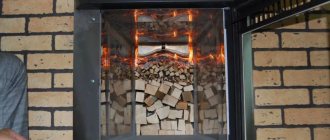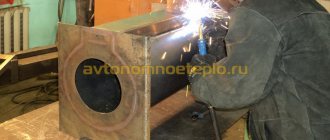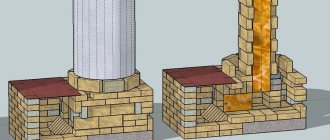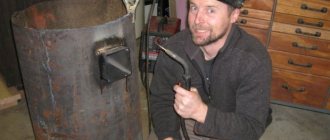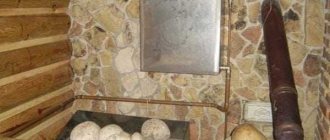One of the most serious mistakes of many owners of country houses is choosing a stove or fireplace design based on exterior features or based on the functionality of a particular design. Which is fundamentally wrong.
Any household stove design is primarily focused on heating the room, and therefore it should primarily be assessed according to these parameters. And only then talk about some additional options or decor.
Introduction
In books about stoves, descriptions or orders of stoves are often supplemented by an indication of their heat output, expressed in kilocalories. In stores, as a rule, the price tag of metal stoves indicates the power of the stove in kilowatts.
At the same time, it is quite difficult for most users to estimate these figures specifically, especially since many manufacturers are disingenuous and in the descriptions of their products (metal stoves) indicate quite fantastic parameters or simply do not say anything, which can lead to the use of an unsuitable model in a room with the specified area.
For example, they often claim that stoves are capable of heating areas of 100 square meters or more without any additional tricks. Which is basically impossible according to the laws of physics - natural convection.
Such a stove is enough to ensure that the temperature in this room is above zero, but the atmosphere in such a room can hardly be called comfortable.
Since the stove itself will have a zone of strong heating and there will be outright heat, but in the far corners the coolness will be clearly felt. And that's only half the story. Most likely, such differences will also be supplemented by condensation and dampness in the corners.
You can only get rid of these unpleasant phenomena by arranging forced air convection (fan), or by arranging forced transportation of heat directly to the problem areas of the room - in other words, by arranging a heat circuit with coolant circulation. That is, turn the stove into a boiler and heat the house with a water system.
Let's determine the heat loss of our home
We need to understand how much energy consumption will be required to maintain the desired temperature in the house. The easiest way to do this is experimentally.
Here is a selection of materials:
IN
Everything you need to know about heating and climate control Features of the selection and maintenance of boilers and burners. Comparison of fuels (gas, diesel, oil, coal, wood, electricity). Do-it-yourself ovens. Coolant, radiators, pipes, heated floors, circulation pumps. Chimney cleaning. Conditioning
In cloudy, windy weather, close all windows, doors, ventilation openings in the house, and turn off all equipment, for example, the refrigerator. We don’t cook anything in the house; it’s better not to be in it at all. We open all internal doors to form a single space. Leave it like this for a day. After a day, we measure the temperature. It is better to measure in all rooms and average.
Now we turn on the electric heater, with a power of, for example, 1 kilowatt. If there are many rooms, then you can turn on several low-power heaters in different rooms. Again we leave it for a day. After a day, we measure the temperature. Again, it is better to measure in all rooms and average.
This experiment can be done at any time of the year. Basic temperature values do not affect the result, only relative changes are important. But it is necessary to conduct the experiment in cloudy weather. Sunlight, especially the infrared component, will spoil all measurements. And you need wind, since heat loss with wind is usually several times higher than without it.
We calculate the difference in average temperature without and with heaters. Divide by the power of the heaters in kilowatts. We get a number that shows how many degrees Celsius the temperature in the house rises from a one-kilowatt heater. In my house it turns out to be 10 degrees per kilowatt.
Basic concepts and terms
On “store-bought” stoves and fireplaces, the heat output is usually indicated, as already mentioned, in kilowatts. For one simple reason: it’s easier to calculate the area that they can heat.
In rooms with a ceiling height of up to 3 meters, 1 kilowatt is 10 square meters of area. Accordingly, an 8 kW oven in theory heats 80 square meters.
And the same data is given for fireplaces. Which, in fact, should be classified as fireplace stoves, not pure fireplaces. And in this case, the indication of their power is correct (however, in many models you cannot open the door while burning, but that’s the tenth thing).
But transferring this template to brick structures no longer works correctly. It is also customary in books on stove crafts to indicate thermal power in kilocalories. And here comes the confusion.
Let's start with the fact that a heating stove and a fireplace are completely different designs with completely different tasks. And they are calculated using different formulas. And also iron and brick stoves, although they are relatives, are very distant. And therefore they work completely differently.
To understand the question:
metal conducts heat well, but accumulates it poorly (it warms up quickly and cools down quickly). And that’s why all metal stoves heat while fuel burns in their fireboxes. To increase the period of their activity, long-term combustion systems are installed. And the calculation of their power is carried out precisely taking into account this feature.
But brick stoves for the most part belong to heat-intensive structures of periodic heating, and therefore they are heated for a couple of hours, and then they give off the accumulated heat for a long time, gradually transmitting it from their depths to the outer walls. And therefore, their power (directly related to their mass and size) should be calculated somehow differently.
In general, without the use of artificial convection, one oven can heat approximately 30 - 40 square meters. In a larger room, it will no longer be possible to provide comfortable living conditions - all because of the same uncomfortable temperature gradient, which increases with distance from the heat source (stove).
But with the fireplace the picture is somewhat different. The fireplace heats the room only during its operation while the fuel is burning. And it warms with exceptionally radiant heat. No heat storage. And therefore its efficiency does not have record values. Approximately 33% when burning wood and up to 55% when using coal.
But for a stove, 80% efficiency is quite an ordinary value. But the fireplace has a huge advantage. Taking combustion air into the open firebox, the fireplace does this with a reserve, an excess. And therefore the fireplace ventilates the room very well and dries it. And the fireplace warms up this volume as quickly as possible.
Photo of an antique fireplace
It is for this reason that the fireplace was preferred in many European countries. Particularly indicative in this regard is Britain, where the climate is quite mild, but excessively humid, and where the heating problem was not as acute as the need to get rid of excess humidity in housing.
For the same reason, pre-revolutionary manuals recommend having a fireplace in a large apartment in addition to stoves - to organize normal air exchange. And therefore, fireplaces were often built in hospital wards - a kind of analogue of quartz.
So the fireplace is no longer considered for reasons of replenishing the heat loss of the building, but from the standpoint of normal air exchange. And therefore, the methods for calculating a stove and a fireplace differ radically.
The power of the stove must correspond to the heat loss of the room. A lack of power will lead to a decrease in the environment of the room (it will simply be too cool), and an excess will lead to excessive fuel consumption.
Figuratively speaking, the picture is somewhat similar to choosing an engine for a car. It is stupid to try to produce a mini-Cooper with an engine from a mining dump truck, just as it is useless to equip this dump truck with an engine from a compact passenger car.
An oversized fireplace in a small room will suffer from a lack of oxygen required for normal combustion of fuel. And therefore it will either start to smoke, or create such a draft that the doors will simply begin to slam intensively. Well, a fireplace that is too small in a huge room will be useless - it simply will not warm it up.
The weight of dry firewood depends on its density.
Based on the density of wood, all species are divided into three groups:
- with low density (540 kg/m³ and less) - spruce, pine, poplar, balsa, fir, cedar, juniper, aspen, willow, linden, alder, chestnut;
- medium density (540...740 kg/m³) - larch, birch, beech, oak, maple, ash, walnut, rowan, apple, pear, elm, hazel;
- high density (750 kg/m³ and more) - acacia, hornbeam, iron birch, oak, ash, keruing, boxwood, pistachio.
How many kilograms of wood are in the firebox?
Knowing the approximate weight of a cubic meter of firewood and the volume of the firebox, we can calculate its power.
To calculate, we need to understand how much of the firebox volume will be filled with firewood and how much air will remain.
An example of calculating the power of the firebox and furnace:
Brick hob, no oven.
The firebox of this furnace has a volume of 0.05 cubic meters.
It will be filled with firewood by 50%, taking into account the air between the logs, etc.
We get 0.025 cubic meters of firewood in a fully loaded firebox.
Taking the average weight of wood and multiplying it by the volume of firewood in the firebox, we get the weight of one stack.
I consider birch because For me this is the most acceptable fuel.
0.034 * 640 = 16kg.
Now we have found out how many kilograms of firewood are in one furnace firebox.
You can begin to calculate the power of the firebox.
Calculation of the firebox power of a wood-burning stove.
Knowing the weight of the fuel burned and the specific heat of its combustion, we calculate the power of the furnace .
The weight of firewood in one stack is 16 kg.
The average value of the calorific value of dry firewood is 13,000 kilojoules per kilogram.
16*13000=208000 kilojoules.
For convenience, we convert kilojoules to kilowatts.
1 KJ = 0.00027778 Kilowatt.
208000 / 0.00027778 = 57.7 kilowatts.
Almost 58 kilowatts of combustion power in this stove, not bad for such a little thing.
What will be the power of a heat-intensive stove with such a firebox?
The power of the furnace is calculated based on the power of the firebox and the efficiency of the furnace itself.
For example: if we assume that the efficiency of this furnace is 70%, we get a power of 40.6 kW. per cycle.
To calculate the furnace power in kWh. we need to divide the total power by the cycle time.
The combustion cycle is the entire time from firebox to firebox.
With double heating per day, the cycle lasts 12 hours.
40.6 / 12 = 3.38 kWh.
The power of this stove is 3.38 kWh, which is a good result for such a little thing.
Fireplace calculation formula
The fireplace is easier to consider, so let's start with it. There are only a few postulates and they are easy to remember.
The area of the portal (the area of the opening of the open fireplace insert) should be within 1/65 - 1/80 of the area of the room. Regardless of its height. The optimal ratio is 1/75.
At the same time, the height of the chimney of any fireplace must be no lower than 5 meters. At lower altitudes, smoke may occur. And the cross-section of the pipe must be at least 1/10 of the portal area. But not less than 1 brick. That is, no less than 120x250 mm.
The firebox is made with a depth of no more than 2/3 of the height of the portal. A smoke collector is placed above the firebox, the volume of which should be at least 1/6 of the volume of the firebox. Actually, this is all the data for a fireplace with an open firebox. If these proportions and dimensions are observed, the fireplace almost always works without problems, regardless of the weather outside.
Problems with the operation of the oven
If the stove doesn’t burn, no matter how good the wood or coal you put in it, it won’t work. The problem is obvious and lies in cravings. Once you increase it, the effect is immediately noticeable. Most problems with the operation of the stove are associated with insufficient chimney height.
Therefore, first of all, we pay attention to whether the chimney pipe is of sufficient height. Ideally, it should protrude above the roof of the house by at least half a meter. Although everything here largely depends on the exact location of the building.
The second point is related to insufficient insulation of the chimney. If the chimney pipe is poorly insulated, the stove will take a long time to burn, and there will be many more problems with its operation. If the chimney is made of brick, then there is no need to insulate it, unless you plaster it with clay, and that’s all. In other cases, it is recommended to insulate the chimney pipe.
Manufacturer's recommendations
When calculating the furnace power, be sure to take into account the recommendations of the company whose products you plan to purchase for heating your home. The Teplodar catalog clearly indicates for each model what size room it is designed for. Thus, the Meteor-220 solid fuel stove with a hob and long-burning mode is intended for heating houses with a volume of 150-220 cubic meters. meters.
For a compact country house, the optimal solution would be the Matrix-100 stove: the maximum volume of housing that it can fully heat is up to 100 cubic meters. meters. The model is also equipped with a hob, a glass door and a long-burning function. You can use firewood or wood briquettes as fuel.
Thus, when calculating the power of a stove for heating a house, it is important to take into account not only the size of the living space, but also a number of additional factors. If you don’t know which model is best for your cottage, cottage or garage, contact our consultants by phone and they will readily answer all your questions.
How to calculate stones
It is important to calculate the amount of stone that is placed on the stove, first of all, for a Russian bath . It is the energy accumulated by the cobblestones that will be used to generate hot water vapor.
Important! Owners of homemade bathhouses face the greatest difficulties in calculating the number of cobblestones. If you choose an excessive volume of stone, it will take a long time to warm up and create a load on the furnace elements. If there are few stones, it is almost impossible to create comfortable conditions for relaxation in the steam room.
According to some calculation algorithms, for 5 bathhouse users it will be necessary to load as much as 250 kg of cobblestones. This figure is unacceptable for most owners of homemade steam rooms. Therefore, you should use very old advice. It reads:
- for 6 liters of evaporated liquid you need to choose 8 kg of stone;
- for every cubic meter of steam room (taking into account losses on windows, doors, bricks), an additional 1.5 kg of cobblestone is added.
According to the average statistical estimate, one person spends from 0.5 to 0.8 liters of water per hour in a steam room. Thus, for a steam room for 5 visitors, you will need to evaporate 4 liters of liquid every hour. Even if you expect the room to be used continuously for 4-6 hours, the total requirements for the amount of water should be reduced by a third, since the steam room will be ventilated and its visitors will take breaks.
As a result, it turns out that it is reasonable to expect the stones in the bathhouse to evaporate about 19 liters of water. This is approximately 40 kg of cobblestone. By adding the required mass to the volume of the room, you can get a fairly acceptable amount of stone that can easily fit in any bathhouse.
Additional factors for improving heating in the house
You can improve the heating of your home not only by improving the firebox and heat removal. By reducing the heat loss of a building, more significant results can be achieved. Installing high-quality windows, insulating floors and walls, installing an air recirculation and recovery system is sometimes cheaper than redoing the heating system.
When improving heating, you should use only proven methods for improving fuel combustion. In this case, it is better to calculate the savings and funds spent on refurbishment.
Plank lining of the rough ceiling on wooden beams
The most suitable sheathing option must be chosen based on the characteristics of the building, the method of its insulation, the presence of a warm or cold attic space, the material of the walls, and the humidity of the atmosphere inside the box.
The ideal option for a rough ceiling may well be considered to be padding the wooden floor beams with a regular shalevka or edged board.
There are three most proven flooring methods:
- Fastening long boards along the lower ends of the rough floor;
- Installation of boards on skull strips;
- Flooring on the outer surface of wooden beams.
At first glance, the material options are not much different, but this is not entirely true; there are certain differences. Before hemming the rough ceiling along the beams, you need to pay attention to the structure of the attic and ceiling.
Laying a wooden batten along the upper plane of the beam is used only in case of a serious need to increase the height of the ceiling or to arrange winter-type attic rooms. In this case, to reduce losses, the floor is insulated with an additional layer of mineral wool over the rough sheathing of wooden beams. Removing the logs from the insulation layer reduces heat loss and significantly improves vapor barrier.
Dimensions for firewood
Given the high flame trunk, experts recommend making a firebox for wood with a height of 80 cm to 1 m. If these parameters are not observed, the combustion of volatile substances will not occur, as a result of which these particles will settle in the chimney system.
Over time, a significant layer of soot will accumulate, which will lead to a decrease in the efficiency of the entire furnace. In order for the coals to roll, it is necessary to slightly bevel the corner parts of the firebox, which are in direct contact with the grate.
Materials
The materials from which the stove is made are important:
- Cast iron fireplace stoves are the most durable and retain heat better. Of course, they are not heat accumulators, since their weight is very small, but they cool down 2-3 times longer than steel furnaces.
- steel stoves with cast iron, ceramic or fireclay inserts in the combustion chamber. They heat the room quickly and are much lighter than cast iron.
- stainless steel ovens. They release heat even faster than lined steel ones. But the thermal radiation from them is harsh. They are afraid of overheating, since stainless steel is greatly deformed at high temperatures.
How to calculate the volume of the firebox
Calculating a stove for a sauna, which you plan to make yourself with power from the mains, is quite simple. It is necessary to obtain the final power requirements and then calculate the required number of heating elements based on their characteristics and wiring capabilities.
However, bathhouse owners often have difficulty determining the parameters of wood-burning stoves. There is nothing complicated here either. It is enough to calculate the volume of the firebox, the compartment where the fuel will burn. The calculation formula is simple:
- the volume is calculated by dividing the required power by 0.6 for a stove installed directly in the steam room;
- The combustion volume of the firebox is equal to twice the calculated power if the stove is located in an adjacent room.
The resulting figure is measured in liters. To roughly estimate the dimensions of the firebox, you need to take the cube root from it and divide the result by 1000. This way you can get the value in linear meters. However, this is a rough estimate. It will show the side of the cube without taking into account how the geometry of the firebox fits into the existing room.
Afterburner reserve
Experienced builders of baths and saunas recommend increasing the final power of the stove by 10-15% of the calculated one. The idea of such an action is very simple. Firstly, the ease of use of the oven is improved. It does not need to be heated to the limit and constantly monitor the amount of fuel or temperature. The unit will not operate at peak power levels, allowing a certain range of adjustment.
Secondly, for bathhouses that are not constantly visited, it becomes possible to quickly warm up with afterburner. This is especially important for buildings in suburban areas. For such a bathhouse, which in winter can literally freeze through and through, you can accept a tolerance of 20%. This will allow you to quickly prepare the room and quickly start taking thermal procedures.
These figures are correct for wood-burning stoves. If an electric unit is used, a power reserve is always made. This may be a tolerance of 10-15% to neutralize possible voltage surges and different heat transfer modes. If there is a need for accelerated heating of the room, it is recommended to select the power of an electric furnace (especially a home-made one) 20-25% higher than the calculated one.
Efficiency
The efficiency factor is defined as the ratio of the amount of thermal energy transferred from the stove to heat the room to the amount of energy that can be obtained from complete combustion of the fuel, expressed as a percentage.
It is clear that the higher the efficiency of the stove, the more heat will enter the room and the less will go into the chimney. The efficiency of furnaces ranges from 60 to 80%. High efficiency is always good, but what makes it so? What new technologies are used in modern furnaces that affect high efficiency and power levels?
The flue gas afterburning system promotes more complete combustion of fuel in the furnace. The combustion of flue gases is carried out by supplying air to different parts of the combustion chamber. From chemistry course we know that oxygen serves as a catalyst for combustion. It then enters along with the air through special channels and flue gases containing carbon particles are burned secondary or tertiary. That is why there is a double and triple combustion system for flue gases. At the exit from the furnace, the flue gases become colder after afterburning, which means that more heat has been released into the room and not into the chimney. The higher the degree of afterburning of flue gases, the higher the efficiency indicators! In addition, the air, rushing into the combustion chamber and igniting in it, creates an unimaginable fire show,
The quality of firewood greatly influences thermal efficiency
heating stove
. It is necessary to use only dry wood and wood, both on the chimney.
When burned, coniferous wood produces a lot of soot, which sticks to the glass and to the inner walls of the pipe. Consequently, you will have to clean the chimney and glass much more often. There is a high probability of this soot igniting inside the chimney. The ignition temperature of soot inside a chimney can reach 1500 degrees Celsius, since it is carbon in its pure form. The chimney will only withstand this temperature for 15-20 minutes, then the chimney is destroyed and there is a danger of fire.
Be extremely demanding on the quality of the fuel you use!
Advantages of stove heating
Wood burning stoves heat up quickly and distribute heat over a long period of time. The brick emits radiant energy, which is good for health. A house where a stove is installed is always comfortable and warm. Thanks to draft, natural ventilation is created in the room. The designs often have a hob on which food can be prepared. In addition, such a stove can be used to dry clothes, shoes and food.
A combination oven is a device that has several functions. This includes a fireplace stove, a heating and cooking stove and a Russian stove.
The only significant drawback is poor heating of remote rooms. That is why they try to install the entire structure in the center of the house for uniform heat transfer. In large houses, it is advisable to install several stoves that have a combined chimney. The hob is usually installed towards the kitchen.
Heating equipment differs in appearance and design.
Usually the stove is installed between several adjacent rooms so that they all heat up evenly Source pechnoy.guru
Glass cleaning system
Separately, I would like to dwell on the glass cleaning system. There are several systems:
- Cleaning glass with cold air.
This is done through the gap between the glass and the cast iron frame of the stove. Air flows from top to bottom, creating a barrier between the source of ignition and the glass. Disadvantage: carbon deposits remain on the glass, which are very difficult to clean.
- Glass cleaning with hot air (CB).
In my opinion, the most effective glass cleaning system. The air into the firebox is supplied already hot, thanks to the double body of the furnace. Through special channels in a double housing, air is supplied to the glass and cuts off soot from the glass.
- Double glass.
The effect is better than cleaning glass with cold air, but there are additional cleaning difficulties due to double glass. – pyrolysis spraying. This coating on glass, in the form of a film, protects the glass from the formation of soot on it. But it burns out over time and the effect disappears.
